Lens: Gold Sol-X Mirror
- VLT: 7%
- Base: Dark sienna brown (Sol-X)
- Mirror: Multi-layer Gold
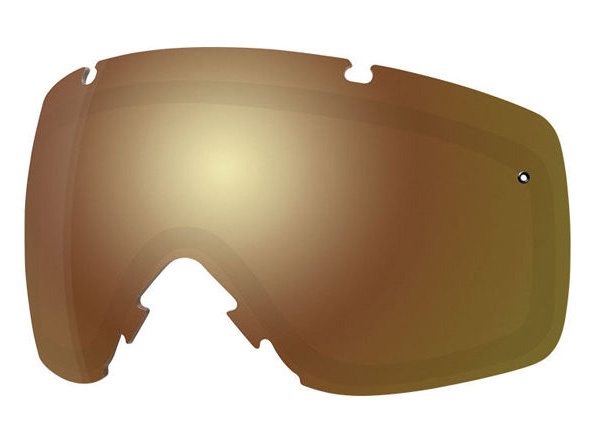
JD: An incredibly dark lens. Designed for bright sun and nothing else, it’s my lens of choice while riding Mt. Hood in the summer and during late spring backcountry sessions where there are no clouds in sight. The gold tint has inspired my friends and me to dub it “the astronaut lens.”
Lens: Blackout
- VLT: 10%
- Base: Dark Grey
- Mirror: NONE

JD: The Blackout lens offers an alternative to the super-mirrored look of the Red/Green Sol-X and Chromapop Everyday. It’s not incredibly versatile, but can handle more clouds than the Gold Sol-X.
WB: If UV protection and fighting super bright conditions is what the day calls for, this is my go-to lens (especially if I’m not feeling the mirrored look or slightly lighter tint of the Green Sol-X.)
Lens: Green Sol-X Mirror
- VLT 15%
- Base: Dark Sienna Brown (Sol-X)
- Mirror: Multi-layer Green
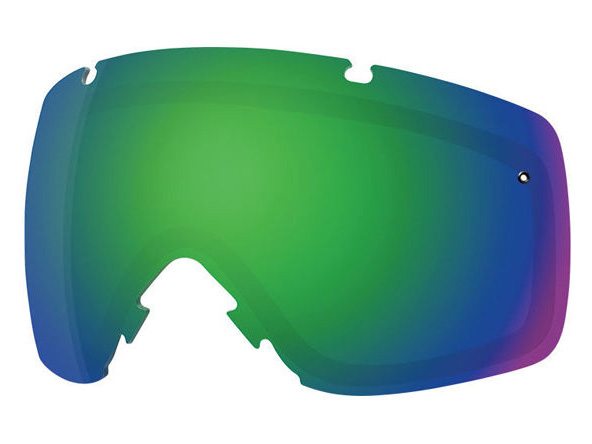
WB: An awesome bluebird lens. I find it surprisingly capable in late-in-the-day shadows and generally more versatile (for a darker lens) than a rose, blue, or grey tint bright-light lens. Plus, for what’s it worth, I think the purple/green mirror is rad. One of my all-time favorites.
JD: My favorite of Smith’s high-light lenses. It handles Mt. Hood-level sun and has the best contrast and versatility in cloudy and shadowy conditions among any Sol-X lens I’ve worn. It doesn’t feel quite as dark as the Red Sol-X and is better in bright sun than the Platinum Mirror.
Lens: Red Sol-X Mirror
- VLT: 17%
- Base: Dark sienna brown (Sol-X)
- Mirror: Multi-layer Red
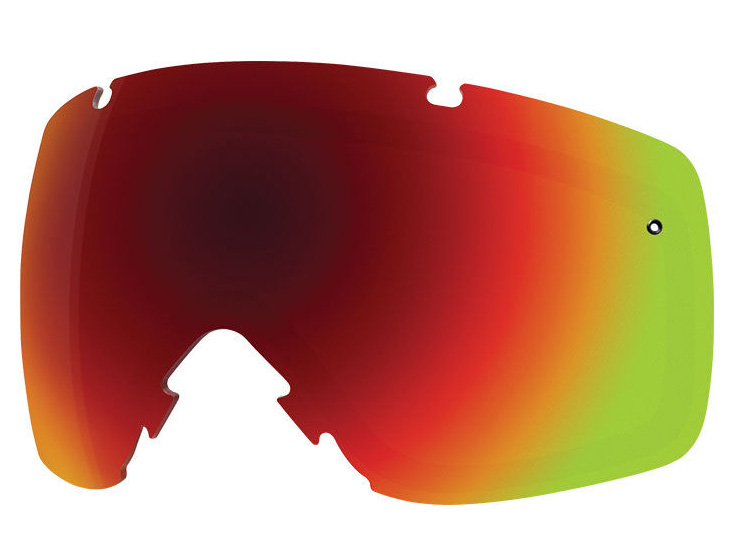
JD: A great sunny-day lens. Although its VLT is 17% as opposed to the Green Sol-X’s 15%, it looks darker to me personally. More at home in bright sun than the Green Sol-X, though not as strong in flatter light when afternoon shadows start to creep in. I reach for it in similar conditions as the Gold Sol-X
Lens: Photochromic Red Sensor
- VLT: 20-50%
- Base: Photochromic Inner
- Mirror: Red Sensor Mirror
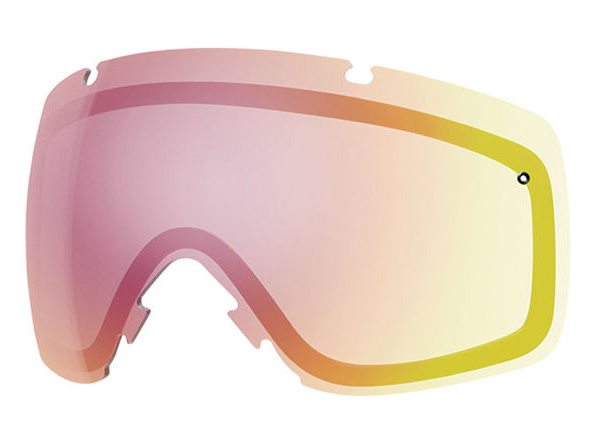
JD: One of my favorite “one-lens quiver” options, the other being Chromapop Everyday. If I have no idea what the light is going to be like that day, I generally go for the Photochromic Red Sensor, especially if the day starts out cloudier.
WB: Smith claims this lens is designed to darken throughout the day, adjusting from morning shadows to late afternoon glare, and that’s just what it’s is great for. It’s not an ideal low-light lens (as it won’t get as light as the Sensor Mirror, which is certainly better suited for overcast and storm days), but does much better than any Sol-X lens in afternoon shade. This can literally turn into a very good low-light lens, and it can also be quite close in performance to the Green Sol-X in sunny conditions, but has a cooler, more blueish tint to it. If you ski in the sun a lot, but have a home mountain that gets shadowed out late in the day, throw this in, and you probably won’t be changing lenses. For storm riding (snowing and flat light conditions), I still swap out this lens for the Sensor Mirror.
Lens: Rose Platinum
- VLT: 25%
- Base: Rose
- Mirror: Platinum
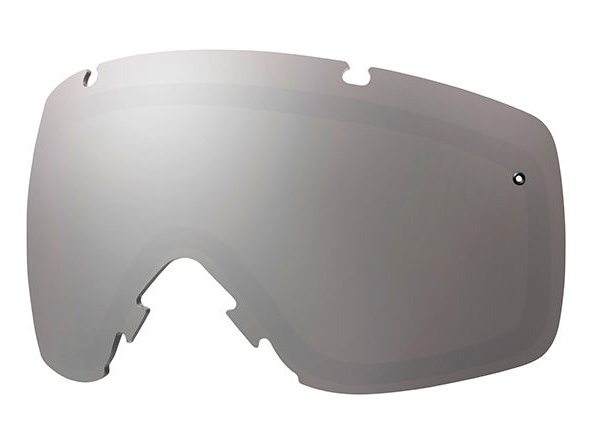
JD: A slightly darker and rosier base than the Ignitor Mirror make it a mid-to-high-light lens that can handle shadowy afternoons. The Platinum Mirror fills the void between the Ignitor and Sol-X lenses. It’s comparable to Chromapop Everyday, but has a much rosier tint and slightly less low-light versatility.
Lens: RC Polar
- VLT: 25%
- Base:Rose
- Mirror: None
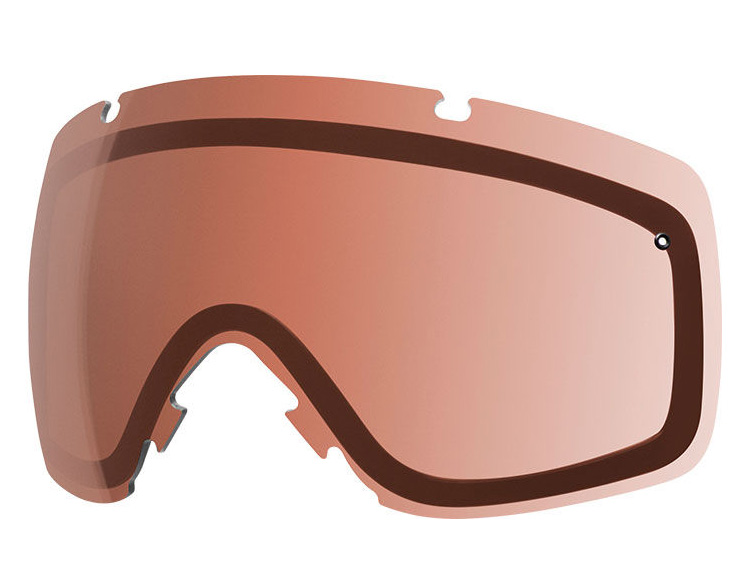
WB: Not surprisingly, this polarized lens noticeably amps up detail and snow texture, helping increase depth perception. I can’t say I find this to be the best mid-day, bluebird lens out there, nor is it the best low/flat-light lens. But it performs impressively in both, providing a nice warm tint. If you’re looking to spend on a very versatile lens to use any day except strom days, consider this as an alternative to the Photochromic Red Sensor, which has a cooler, blue tint.
Lens: Ignitor Mirror
- VLT: 35%
- Base:Rose
- Mirror: Silver/Platinum
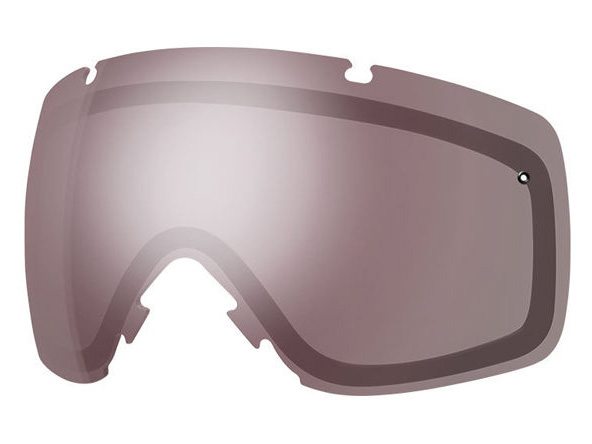
JD: This is Smith’s flagship all-around lens, and rightfully so. It is incredibly versatile, effective in high-light conditions and even a passable low-light lens. I don’t use the Ignitor too often, as it’s less specific than the rest of the line, but for those that are looking for a lens to do everything, the Ignitor is Smith’s best offering.
Lens: RC36
- VLT: 36%
- Base: Rose/Copper
- Mirror: None
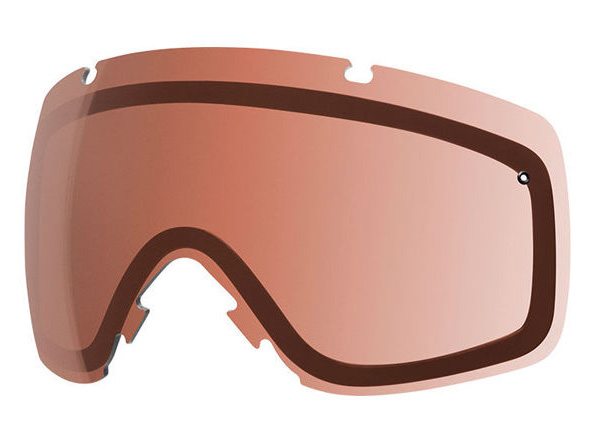
JD: This lens is relatively low-tech, with an amber base and no mirror. However, its tint is great for lower-light days that might not warrant a Sensor or Gold Sensor. I like the classic look of the RC36, and usually use it in similar conditions as the Ignitor.
Lens: Red Sensor Mirror
- VLT: 60%
- Base: Light Rose
- Mirror: Multi-layer Red
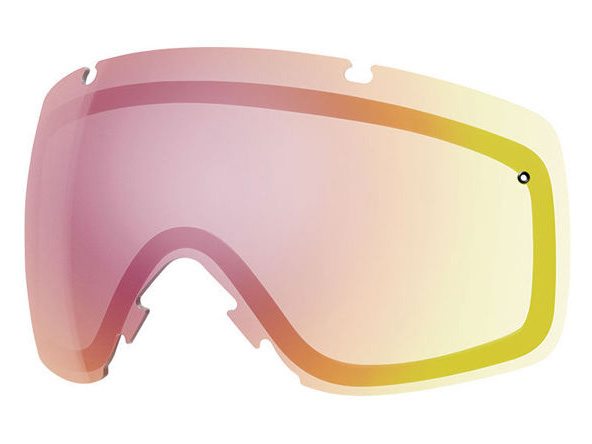
JD: The Red Sensor is rose-based like the Sensor, but is definitely better for a slightly different set of conditions. The Red Sensor’s mirror makes it slightly darker and not as strong as the Sensor when it comes to contrast in flat-light conditions. However, its effectiveness reaches farther into the mid-light range than most of Smith’s other low-light lenses, one notable exception being Chromapop Storm. I usually pack a Red Sensor on darker partly cloudy days when the light is variable and could change run-to-run.
Lens: Yellow Sensor Mirror
- VLT: 65%
- Base: Yellow
- Mirror: Blue
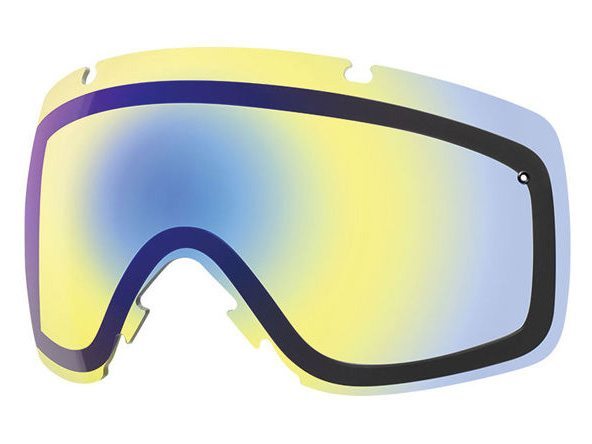
JD: The Yellow Sensor is a comparable option to the Blue Sensor for those who like yellow-based lenses. It provides a warmer field of vision, and gives great contrast in low light but is not as versatile as the Blue Sensor for dappled sun conditions. Great for night riding as well.
Lens: Blue Sensor Mirror
- VLT: 70%
- Base: Light Rose
- Mirror: Multi-layer Blue
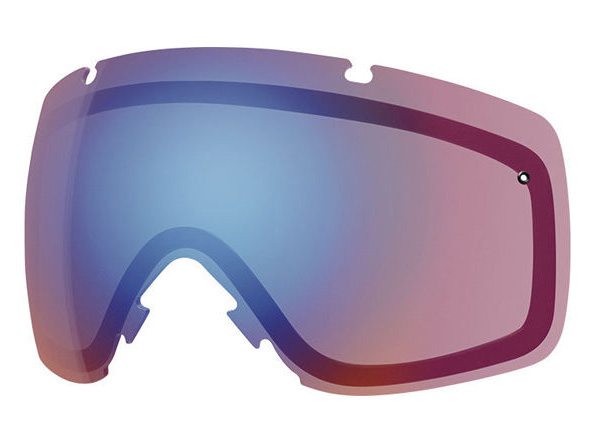
JD: This is Smith’s best ultra low-light lens in my opinion, though Chromapop Storm is a very close second. Its tint is exceptional at bringing out nuances in the snow, and in my experience provides the best low-light contrast of any of Smith’s lenses. High VLT yellow lenses are great in very flat light, but if the sun happens to come out, it’s almost painful to the eyes. While the Sensor is by no means a high-light lens, in my experience it has outperformed most of its competitors in its versatility.
WB: For a low-light, rose-tinted lens, the Sensor Mirror is as good as it gets—if I’m wearing my I/Os. This is my go-to lens for overcast days and low/flat-light conditions. It provides good color transmission and a slight contrast boost for better depth perception. In my opinion, a yellow-based lens will do best to help you see best in full-on flat light and storm riding, but you’ll be squinting with that sort of lens when things get remotely sunny (not always the case with the rose-based Sensor Mirror, which can still serve you well in slightly brighter conditions).
Lens: Clear
- VLT: 84%
- Base: Clear
- Mirror: None

JD: I only use clear lenses when night riding. Some people I’ve talked to like them for low-light conditions, but I don’t feel I get enough contrast without any tint.

For the past 25 years I’ve used either Smith’s Gold-lite or RC36 lenses in all conditions, without issue. One lens does it all, and lasts for years. The few times that I’ve tried to use any of Smith’s mirrored lenses I experienced distracting reflections – drops of moisture on the lens or the most minor of scratches created obvious distorted visual effects, and I concluded that mirrored lenses were just a gimmick and not for me. Am I just unusually sensitive, or have the mirrored lenses improved (it’s been at least 5 years since I gave up on them) to the point where this isn’t an issue?
Hey Stewart,
Your concerns are definitely valid. Mirror coatings on lenses make scratches much more prominent than on a lens like the RC36. However, some mirrored lenses (in my opinion) allow for much higher optical clarity and contrast, and the anti-scratch technologies have almost certainly improved in the past 5 years. If you were wearing stamped lenses (rather than spherical) the mirror coating would have definitely been less durable than in a spherical lens, and caused much more distortion as well. I think you should try out the Sensor and/or Ignitor, they’re both all around lenses and I think you’ll be pleased with the Ignitor’s performance as compared to the RC36 in sunny conditions.
Thanks,
Jed
Thanks for the excellent review. I bought the green sol x and the sensor mirror. Is there one lenses I between that would be best for typical spring day with snow then sun then then snow then sun…?
Hey Randy,
The Ignitor, RC36, and the Photochromic Red Sensor would all be up to the task. If I were you, I’d go with the Photochromic Red Sensor- its technology makes it the most versatile among Smith’s mid-light selection.
Thanks,
Jed
I don’t see the Sensor Mirror on Smith’s Website? Is that something they have renamed? I was looking for a low/flat/storm lens for my new I/Os – I’m giving up my Oakley A-Frame High Intensity Yellow after may years :)
Hey Todd,
It’s called the Blue Sensor Mirror.
https://www.smithoptics.com/
Thanks,
Jed
Jed,
Awesome – and thanks so much for this great review, I really found it very helpful.
Thanks,
Todd,
Questions on the Photochromic Red Sensor:
Do you have a feel for how quickly they lighten up?
I am fine if they are relatively low tint in a slot of bright light/snow while skiing, but the opposite is not true. I would hate not to see something important if I ended up in the shadow of a cliff or some trees.
Any thoughts? Thanks.
Hey Nick,
If you’ve been riding in really l bright light and then move into a shadow, the lens isn’t going to lighten up in a matter of seconds. However, the VLT range is narrow enough that the lens at its darkest doesn’t make going into shadows momentarily too dangerous. In other words, it’s not going to get too dark in the sun in the first place to make seeing in localized shadows extremely difficult.
The lens doesn’t change too suddenly, certainly not instantaneously. In fact it’s hard to discern it changing, but easy to notice once it has changed. For example, I notice that I’m able to see quite well on the shadowed out front side of Taos (late in the afternoon when most of the mountain is in shadow) with the same lens that was doing great in super bright light earlier that morning. It ultimately adjusts to much broader, ambient light changes from morning sun to the cooler, lower afternoon light, not so much moment-to-moment changes from a sunny spot into shadow.
Hope this helps give you a better sense of how the lens performs.
Will
Hi,
found this guide really useful!
i bought the virtue goggles and they came with the green sol-x lens, which hopefully i will use but i wanted something more for lower-light, but the only options to buy in uk are the ignitor and rc36 (going to Val Thorens in less than 2 weeks didn’t want to risk international shipping) could you give anymore detail on what would be a good option? i’m kind of leaning towards the ignitor if it’s very versatile?
thanks!
Mist,
If you’re going for something for low light, those are going to be pretty similar. their VLT values are pretty close, but if I had to choose one to have with the green sol-x, I’d probably go with the RC36. by a hair, I would prefer the rc36 in low light conditions, and the mirrored igniter is probably more versatile. hope this helps.
thanks,
Jed
Hi,
I am a beginner snowboarder and don’t go very often and I want to buy a goggle that I can use all the time (I won’t go snowboarding on really bad days). I’m deciding between the ignitor and the red sesor, which one is more suitable? Does it make a difference is I have astigmatism?
Thanks!
Denise,
I’d go with the Ignitor, it’s the best all-around lens I’ve ever had. I can’t speak on how each one will perform with your astigmatism, but I don’t think one will be better than the other. I have mild astigmatism in my left eye and both lenses work great for me.
Thanks,
Jed
This was a great help. I am going from Smith Fuse goggles with gold sensor/Ignitor lenses to I/O with Blue sensor/Red Sol-X. Even more pleased with my choice now. Before the Ignitor could be a bit light on super bright days. The gold sensor was good in low light/foggy/snowy conditions but if it did brighten up some I would get headaches quick. Seems the blue sensor could help avoid some of that till I can (quickly now) swap out lenses.
Hi,
thanks for another best review on the internet.
My resort has 2 sides. North one is in shadow for almost all winter long. Which lenses is best for bluebird days in huge shadow? I´m considering Ignitor Mirror. I have red sol-x mirror for sunny days on the south side and blue sensor for cloudy or stormy days.
Thanks
Martin
Martin,
I think the Ignitor does very well in shadows and in bright sumlight. I think you’ll really like its versatility.
Jed
Hi guys, great review. Im looking at the dr bob goggles which come with the yellow lens and the Ignitor lens. Have you guys got any experience of the Yellow lens? Would that combo cover me for most conditions?
Tom,
Unfortunately Yellow is the one lens in Smith’s I/O line that I don’t have any experience with. However, I’m pretty confident from what I’ve heard from riders that swear by it that it’s a capable low-light and storm day lens that you wouldn’t want if the sun was out. Pairing that with the ignitor (or even one of the Sol-x options if you want better bright-sun performance) should be a great combination.
Thanks,
Jed
Thanks Jed, that’s very helpful.
My other lens combo option here is for the blackout + red sensor mirror – but i’m worried that wouldn’t give me much mid condition coverage – do you have an opinion on that vs yellow+ignitor?
Thanks
Tom
Tom,
Blackout and Red Sensor is another good option. It depends a lot on what light conditions you’re dealing with normally. Ignitor/Yellow will be solid in low and mid light conditions, but some people prefer a darker lens than the ignitor for bright sun. With the blackout/red sensor combo you’ll be happier in bright light, and solid in low/flat light. I personally am fine with the red sensor when the sun is out but areas are shaded out, but I can see why you would be concerned about missing the ignitor for mid-range versatility. So basically, the red sensor is more versatile than the yellow, the ignitor is more versatile than the blackout, but having a more specialized lens isn’t necessarily a bad thing. You won’t go wrong with either option.
Thanks,
Jed
I am looking to purchase the Smith I/o goggle and I’m looking at two goggle choices….either the red sol x with the red sensor…..or the platinum mirror with the red sensor???? I guess the decision really comes down to the platinum mirror vs the red sol x mirror because the red sensor is in both.
Do you have thoughts or opinions?? I do like the mirrored look.
Hey Gary, the Red Sol-x and Platinum mirror are both great sunny-day lenses. The red Sol-x will be better in bright, full-sun conditions, and the Platinum will be more versatile. The Blue sensor is the same as the Sensor listed in this review.
Thanks,
Jed
I see there is also a Blue Sensor lens on the site. Have you tried it? Thoughts?
Thanks, this guide is well written and very helpful but how do you tell the different lenses apart? Is there any marking on them? I have two pair of these, the first pair was red sensor mirror and platinum mirror. The second set came with black out and red sensor mirror except it wasn’t a red sensor mirror. Having a tough time figuring out what lens it is. It’s very close to the platinum mirror and now I’m not even sure which one is the platinum lens. I also have the photocromic red sensor which at least has the word photo on the lens. Any suggestions. Thanks David
David,
The Platinum Mirror will have a slightly more reddish tint than the Ignitor. If you still have questions about which one it is, go to a local shop and compare yours with one off the shelf. Hope this helps.
Thanks,
Jed
I found this guide to be super helpful! As a relatively new snowboarder, I am finding that lens tint matters waaaay more than I ever thought. I have Oakley’s with the persimmon lens, but am looking for something a little bit better. Some people say the persimmon’s are the best all around lens for Oakley, but I feel like it doesn’t work amazingly in low light and is pretty good in brighter light. Which Smith lens would you recommend as the best all-around lens? I was thinking green sol-x or red sensor. Just curious as to your thoughts. Sorry if you’ve been asked this millions of times!
Abby,
Glad you found the review helpful. Given what you said about the Oakley persimmon, I’d go with the Red Sensor. If you want something more comfortable on sunny days but still capable in low light, the ignitor is another good option.
Thanks,
Jed
Thanks so much Jed! I think I made the right choice by ordering an I/OS with the Red Sensor Mirror and the Blackout lens. It was the darkest one I could find here in Europe. I heard some people Post-lasik rave about the Smith Green Sol-X Lens but I can’t order it from here.
I have very sensitive eyes after lasik surgery and I am confused about what I should buy. I also have light blue eyes so I need strong protection. These days on very bright sunny days my eyes become red and itchy (even when wearing dark sun glasses) and I get headaches easily. I am afraid it will be much worse on the ski slopes. Any suggestions for `goggles that would meet my needs? I would need something for bright sunny days and also days that are more cloudy.
Chantal,
It definitely sounds like you need a goggle with interchangeable lenses like the I/O for your eye sensitivity. To avoid headaches (if they’re coming from light sensitivity), I’d go with Smith’s darkest lens, the Gold Sol-X, for sunny days (or another lens with a very low VLT, see page 4 of the review). You’ll lose some versatility when riding in lower light or shadows, but that may be a small price to pay if it helps ablate your headaches and itchy eyes. For a lower light lens, to be used on storm days, try the Red Sensor. Because light can change quickly and your eyes depend on it, it’s pretty essential that you have two lenses that are easy to change quickly. Hope this helps, and good luck with your recovery from surgery.
Thanks,
Jed
I got the red sensor mirror and platinum mirror w the goggles on sale. Wore the red sensor for a long weekend in varied conditions and found the bright times of day to cause my eyes to fatigue. I also found it quite hard to see when it was cloudy or stormy. At deer valley, the weather changes peak to peak. How would you suggest utilizing these lenses? Is the platinum mirror more versatile? I do not often change lenses intraday. Thanks
David,
I would definitely recommend bringing your extra lens with you on the hill and swapping it on the lift as needed. try to find a pocket that allows you to match the curvature of the lens to your leg or abdomen- I put it in my front pocket and hardly notice it. I think changing lenses intraday will help solve your problem, but if you don’t want to do that I’d err on the darker side if you’re not sure how the light will be and are concerned about eye strain.
Thanks,
Jed
Hi and thanks for a really good article. I have been looking at both the Zeal Slate goggle and the Smith IO which seems to be getting the best reviews and in particular with regards to anti fogging which is important to me as I tend to steam up. Cost difference is negligible so I guess the Smith IO is the better goggle to go for. The options for lens combinations I am considering are the Green Sol-X with the Red Sensor or Blackout with the Red Sensor. My thoughts from reading the article are that you would probably go for the first combination but please can you confirm. I currently have an old pair of Oakleys with a light yellow lens that are good in low light but leave me squinting in bright light although I have managed to live with them like that to date. Thanks for your help.
Richard,
Green Sol-x and Red Sensor would be a great combination, I’d probably go for that over the blackout just based on my personal preference. However, blackout is my next favorite high-light lens, so i don’t think you can really go wrong. As for the frames, that’s all personal preference; but for what’s it’s worth that trilab colorway is definitely my favorite.
Thanks,
Jed
Hi Jed
Thanks for the reply. Unfortunately I have just noticed that the Trilab strap has Camp Vibes which is probably not the message I want to be giving out on the slopes. Guess it might only relate to tents etc in the States but also has a slightly different meaning in the UK.
Cheers
Richard
Hi Jed
After not liking the strap on the Trilab I am now looking at the Bobby Digital with Green Sol-X and Red Sensor or the Kelly Blockhead with either the same lenses or with Ignitor and Blue Sensor. Which combo would you go for?
Thanks
Richard
Continuing from the previous post I am quite liking the Trilaboration, mud green frame, camo strap and that only comes with the Blackout and Red Sensor lenses. Fashion over performance maybe …….. Thoughts please.
Hey Richard,
All the Smith frames are sick in my opinion, but I don’t think you could go wrong with the Trilab Camo.
Thanks,
Jed
thanks so much for taking the time to make this post. i was tickled to read through the reviews, @ the end to hear “it handles Mt Hood sun,” as I’m moving to Portland and buying new goggles with the hope I get to ski a ton @ MHM!! assuming I only want to buy 2 lenses out of the gate, should I opt for the green sol x + red sensor option, or the blue sensor mirror + ignitor?
Hey Jeremy,
I’d definitely go with the Green Sol-X/Red Sensor pair for shredding MHM (which you should be stoked to ride, it’s one of my favorite resorts and gets really fun with wind lips and jibs in the spring). While I’d prefer the blue sensor over the red sensor for contrast in the mostly treeless Mt. Hood Meadows during flat-light conditions, the Green Sol-X will be better on sunny days and will be fine into late May when MHM usually closes. I think the level of sun in spring/summer will be better suited for the Green Sol-X than the Ignitor. Hope this helps.
Thanks,
Jed
Thanks Jed, much appreciated. I certainly am stoked to call MHM home and have access to day trip skiing. I currently live in Chicago and make it out west just one week a year. So MHM gets alot of sun? I assumed being PNW it would be cloudy + stormy more than anything else. Again thank you for taking time to share your expertise and POV. Shred on!
Jeremy,
In my (somewhat limited) weather experience at MHM, it goes to both extremes. Mt. Hood definitely gets a lot of weather and has little tree cover to help with depth perception higher on the hill, but it also has hands-down the brightest sun in the spring and summer. Take it easy!
Thanks,
Jed
if I have the I/OX with Blackout lens and the red sensor, what lens would you suggest for the mid light. and would you suggest also picking up a green Solex. Ski in Colorado
Hey Bill,
I would definitely suggest the Ignitor as a mid-light lens to complement those two. A green Sol-X will be somewhat similar to Blackout, but I personally like it more in afternoon shadows so that would definitely be an option. Hope this helps and happy shredding!
Jed
Hello,
I was looking at the goggles and I have a question. When the weather is very bad and it’s snowing all day, I can’t see the depths very well. I want to know which colour lens is the best for very bad weather?
Laura
Laura,
I’d go with the Blue Sensor (known by some as just the Sensor). It’s my go-to in those conditions. Hope this helps.
Thanks,
Jed
This post has been a huge help the past couple months as I’ve been doing my research. I’m sold on the photochromic lens as the one to best suit my upstate skiing needs, but, aside from your comments hear I haven’ been able to find more than a review or two on how the lenses work in changing with the light. Could you expand on that a little more? I’m not expecting split-second transformation but hearing that it does what it supposed to do in a timely manner will give me a lot more confidence in my purchase.
Thanks!
Hey Jim,
Thanks for the kind words, and your question about the photochromic tech is a good one. We’d estimate the change time at around 5 minutes to go from lightest to darkest- it’s hard to tell they’re changing when you’re wearing them. From Will Brown-
“The lens doesn’t change too suddenly, certainly not instantaneously. In fact it’s hard to discern it changing, but easy to notice once it has changed. For example, I notice that I’m able to see quite well on the shadowed out front side of Taos (late in the afternoon when most of the mountain is in shadow) with the same lens that was doing great in super bright light earlier that morning. It ultimately adjusts to much broader, ambient light changes from morning sun to the cooler, lower afternoon light, not so much moment-to-moment changes from a sunny spot into shadow.”
The short answer to your question is that yes, they do change in a timely manner, and work well in shadows. Hope this helps.
Thanks,
Jed
Hello! What is the size of helmet maze on the photo? Medium or large!?
Hey Seb,
The Maze pictured is a Large.
Thanks, Jed
Thx!
Hi there,
I bought my 2014 I O goggles last december, and have been looking for a yellow lens ever since, any idea on where to get my hands on one ? sold out ? would the 2015 lens fit the older model ?
Or what would the next best lens be for super flat light ?
Thanks a mil ! :)
Nick,
I’m not sure if they’re still selling the yellow lenses separately, but this frame comes with one:
http://www.smithoptics.com/
Hope this helps,
Jed
Nick,
To answer some of your other questions, I don’t think you can go wrong with the Blue Sensor for low light. It’s my go-to in storm conditions, and will be more versatile than a yellow lens in my opinion. To my knowledge, all I/O replacement lenses will fit last years’ I/O frames.
Hope this helps,
Jed
Hey there!
First off I’d like to thank you like so many here for this great review. I’ve gone back to this article more times than I should admit as I scrutinize over what to buy. Wanted to ask an opinion: between a platinum/blue sensor combo and an ignitor/blue sensor combo, what would you suggest? I don’t get out too much, but I’m looking forward to a couple Colorado and Utah trips this season – so really anywhere from snowstorm to bluebird.
Thanks again for the great review!
Thanks for the kind words! As for your two choices, it depends on your preferences in bright, sunny conditions. The blue sensor will take care of all storm day and low-light situations, so no worries there. Platinum is a slightly more specific high-light lens, so it’ll be more comfortable on sunny days. The Ignitor, though slightly less dark, is really versatile and can handle anything from bright sun to overcast conditions. If you want a darker lens and are willing to switch your lenses out on the hill (which is pretty easy with the I/O), take the Platinum. If you’re looking for something more versatile, go for the Ignitor. I think you’ll be stoked either way.
Thanks,
Jed
Thank you for this awesome review!!!
After reading your review, I finally picked up I/OX with Ignitor, Blue sensor and Green Sol-X to cover all ranges of conditions.
Thanks again!!
I do have a question though. Since I picked the combination of Ignitor and Blue sensor which should be good for most of the conditions. Do you think it’s necessary to get the Green Sol-X for very bright condition? Thank you!
EJ,
I wouldn’t say it’s necessary- the Ignitor does fine in high-light conditions for a lot of people. However, if you can swing it, I would add the Green Sol-X. I prefer it in sunny conditions to the Ignitor.
Hope this helps,
Jed
Hi this was really helpful. I’m an intermediate skier and I’ve never looked into goggles but next winter I’m heading to Mt. Snow in Vermont and I’m thinking I’ll need goggles. (I’ve been skiing locally and the mt. is not too high).
I’m not sure about the weather at Mt. Snow, but I found really good deals online for smith prophecy otg and I’m trying to decide whether to get blue sensor w goggle and buy the rc36 lens or red sol x lens OR buy a pair of ignitors because they are all around conditions (but the frame color is for men but I’m fine because of the price, and I’m a woman).
Please help me! I’m not sure if the extra lenses will fit the frames because they might be different year models and the lenses aren’t bought directly off the smith.com website but through other outlet sites. Should I risk it and buy a goggle and a lens or just stick to ignitor/rc36?
Also is ignitor better to use or rc36? Thanks.
Lil,
Thanks for the kind words. I always like to have two lenses for changing light, but if I had to pick one it would definitely be the Ignitor. If you’re going to buy two, I’d go with the Blue Sensor and either Ignitor or Red Sol-X.
Hope this helps,
Jed
Really a great article guys. Very helpful. Thanks much!
Eric
I just bought yesterday the Smith i07’s Acid block frame with the Green Solx Mirror and bonus lense – red sensor mirror. I noticed when I put these on, the yellow frame reflects off the inside of the lense around the nose, and I can seee the reflection of the yellow lense.
JD, did you have this problem when you were wering the yellow Acid Block frame?
Sean,
I’ve definitely noticed that on lighter-colored (white, acid green) frames when putting them on for the first time, but I think after you start shredding you won’t really notice it- It hasn’t ever been a long-term problem for me.
Hope this helps,
Jed
Thank you so much for this detailed review. It is not often you find such a consise review of topcs with timely responses to questions. Thank you for the help, I have chosen the Mirrored Ignitor for my trip out West to Breckenridge.
I have a pair of io7 with the blue sensor and red sol x I’m looking to get another lends and was curious to see if getting the gold sol x would be worth it when I already have the red sol x. Maybe the ignitor just to have a true mid light condition day. Idk
Trevor,
If you’re going to get a third, I’d go with the Ignitor. The Gold Sol-X will be similar to your Red Sol-X, while the Ignitor will be good for those in-between days.
Hope this helps,
Jed
i cant decide between the blackout lens, or red sol x, both look cool to me, im just wondering if one is more functional than the other. Like are mirrored better than regular?
Thanks,
Jon
Jon,
The Blackout will be slightly darker and less versatile, but overall they’re both optimal in the same light conditions.
Thanks,
Jed
I don’t want to bother with taking multiple lenses to the hill so I was looking for a “one goggle quiver”. The Ignitor Mirror is it. I’ve used them in everything from bluebird spring days to white out conditions. They may not be perfect for extreme conditions, but I’ve got enough decisions to make between layers, jackets, gloves, skis etc… to meet a day’s conditions. Enough already.
Hello there,
I have a quick question please. I am trying to decide between a Green Solex Lens and the Ignitor Lens. I understand they are both a general all rounder lens but which one will give a more natural look? I don’t like tinted lenses that change the colour too much…. I end up with the goggles on my forehead instead as I prefer the ‘real’ look if you know what I mean.
Thanks,
Angela
Hi Angela,
If I were you, I’d go with the Ignitor. I think the mellow rose tint will feel more natural and fit with your preference. It’s also a great all-around lens for any light condition.
Hope this helps,
Jed
Thanks for the great review, but I got a question still:
I’m looking into buying a new goggle and I’m set on getting a pair of smiths.
Price wise (here in europe) I have the option to either get a i/o with 3 lenses (green sol-x, ignitor and blue sensor)
or get a i/o7 with 2 lenses (wich would be yellow sensor with either the ignitor or green sol-x)
I’m skiing in austria and theres a lot of flat light conditions! and theres a lot of trees (so shade/bright rapidly alternating).
What would you reccomend: get the (better?) flat-light yellow sensor lens over the blue sensor and sacrifice versatility. Or go for the 3-lens option because the yellow and blue are virtually the same in bringing out contrast in flat/low-light.
Thanks!
Hey Ingmar,
You’re not going to go wrong with either of these options, but I’d go with the I/O with three lenses. The Blue Sensor is my go-to in flat light, the Ignitor is great for variable light and sun/shade conditions, and the Green Sol-X is the most versatile of the Sol-X lenses in my opinion. You’ll be good to go no matter what the light is like.
Hope this helps,
Jed
Thanks for the great review. Need help decided in combo of lenses. Ski mainly in Mammoth and and looking at the I/O X. Lens combos available are photochromic and blackout or igniter with blue sensor or green sol x with red sensor.
I like the photochromic but am concerned that since it comes with blackout as spare lens this combo doesn’t have a great option for snow/low light. I have never really used a blackout type lenses even on sunny days so I don’t know if I would like it.
Which combo would you choose for sunny days with shadows in the afternoon but then to also have a spare lens for snow/low light.
Thanks
John,
I personally don’t mind the photochromic red sensor on snow days- it’s darker than the blue sensor, but is certainly a passable low-light option. Blackout is one of my favorites for bright sun. That said, if I were you I’d probably go with the Ignitor/Blue Sensor option- the Blue Sensor is ideal for snow days, and the Ignitor is the most versatile high-light lens Smith makes You’ll be covered in those afternoon shadows you mentioned.
Thanks,
Jed
Have you considered updating this review to include information about some of the newer lenses it seems that Smith has added for the 2015-2016 season? They seem to now have a “Yellow Sensor 2 Mirror”, and it seems that there are new versions of some of the lenses (i.e. “Clear 2” vs “Clear”). I also appears there is a “Yellow 2” lens (different than the Yellow Sensor) and a lens called “Play 2”.
Ian,
Stay tuned.
Thanks,
Jed
I have an I/O7 with a Green Sol-X (17% VLT) and Red Sensor (55%) lenses. Since my frame broke two days into a long ski trip right after I bought it, I am going to buy a backup frame for this year’s trip and am looking to get a good set of lenses for all conditions. My two best options seem to be the Photochromic (20-50%) and Blackout (10%), or Blackout (10%) and Yellow 2 (65%). What do you think would be the best set of four lenses? I have been happy with the Green Sol-X even on variable days, only using the Red Sensor when overcast; I found it not fully adequate in very flight light and fog, but not sure the Yellow would be that much better there. The Yellow is tempting for storm days (please, storms, come my way!) but would the Photochromic be the better choice overall? (I am fine adding a fifth lens too, so I could add the Photochromic or Yellow at some point to either set). What do you think would be best? I ski the PNW mostly, with trips to Utah and the Rockies.
Frenchman,
I would add a Blue Sensor, Yellow Sensor, or Yellow to your quiver for storm day riding. Less versatile in the sun when compared to the Red Sensor, but worth it in my opinion. I’d also add a mid-light option like the Photochromic Red Sensor or Ignitor. That lens quiver will be tough to beat.
Hope this helps,
Jed
Hi there. Great job on the reviews. Even the comments section is highly detailed and informative.
I know that the clear lens as well as the blue sensor would be more optimal for night riding, but if possible, I’d like to avoid carry spare lenses. How is the ignitor for night riding?
Kiet,
The Ignitor will be a touch dark for night riding in my opinion. Clear is my favorite, hands down, followed by yellow and blue sensor. You’ll want to be maximizing the VLT at night. If you want to ride one lens day and night, I’d check out the Photochromic Red Sensor though.
Hope this helps,
Jed
What is the visual difference between the platinum and igniter mirror lenses? Does the platinum have a darker mirror?
Justin,
The Platinum has a redder, rosier overall tint, and the mirror is darker.
Hope this helps,
Jed
Hi
My head is too small for interchangeable lenses, and I only ski for one week every few years, so I just want a decent all around lens to replace my trusty old orange lensed goggles that are scratched. The Smith virtue goggle fits, but I need to pick a lens. On really bright days I’d wear sunglasses, but only if it’s not too windy. You seem to prefer the ignitor mirror to the photochromic lens as an all around. Is that true? Which performs better in low light and which in bright light?
Thanks
Camilla,
I’d take the Ignitor in bright light, and the Photochromic Red Sensor in low light. Either will work for everyday riding, but if your eyes are particularly sensitive, I’d go with the Ignitor for those ultra-sunny days.
Hope this helps,
Jed
What lens would you recommend between the green sol x and red sol x. Is there much of a difference. Seems for low light blue sensor is the way to go and that comes with the red sol x.
Stuart,
I think the Green Sol-X is more versatile by a hair, but they’re both high-light lenses. With the Blue Sensor as your low-light option, you won’t go wrong with either one.
Thanks,
Jed
great info and thanks … but i’ve gotten mighty confused.
the goggle i’m considering comes with 2 lens combinations to choose from:
1. a red sol-x mirrror lens + a yellow lens and thanks.
or
2. a red sensor mirror lens + an rc36 lens
can you offer any perspective on the pros and cons of these two options? many thanks.
Hello,
I am looking for a lens combination that would be good for New England Skiing. I experience a lot of shaded trails with lots of trees, so you are always going in and out of the light. I was thinking Green Sol-x and Red Sensor for their versatility. What do you think?
What can you tell me about the Chromapop Everyday?
Brit,
Hoping to update this review soon with Chromapop. Stay tuned.
Thanks,
Jed
Really appreciate your great reviews. Trying to decide between two I/07s for Colorado (mostly WinterPark area):
a) Green Sol-x with Ignitor
b) Red Sensor with Ignitor
Any thoughts? What would you do?
Dave,
I’d go with the Red Sensor/Ignitor combination. It’ll give you better coverage in lower light.
Hope this helps,
Jed
just got my smith I/07 with black out and Photochromic Red Sensor lenses, but i feel like i need something for when it’s getting very dark or when there is alot of snow coming down, i was thinking between the ChromaPop Storm or i know your favorite lens under these type of conditions is the blue sensor mirror, what are your thoughts about the storm lens and which one do you recommend for me? thanks for the advise.
Like always a great review(s)!
Could you do a comparison between chromapop and prizm from oakley? Both technologies looks like they do the same, but which one is better?
Thanks for the update. My favorite low light lens is the yellow sensor which is not included in the above (pretty sure this is not the gold sensor). Would probably go with the chromapop storm now that it is out.
I think Smith has changed the naming on some of these lenses over time (e.g., sensor => blue sensor). Might be worth a small update to standardize on the lense/names you can buy today.
Just wondering, you didn’t mention the yellow sensor mirror Smith came out with last year. I’ve found them to be excellent in poor visibility. Has anyone else had a chance to try them?
Any chance you happen to have experience with the ChromaPop™ Sun Platinum Mirror lenses? I’m in CO so it’s often super sunny and I also had LASIK so my eyes are more sensitive to light than normal. Making me thing I want something darker than normal “everyday green 23%” but can’t find these to test so wanted to make sure the tint & contrast is still good. Otherwise I’ll probably go with every day green at 23%. thanks!
Hey Clay,
Unfortunately I haven’t been out in the ChromaPop Sun Platinum, so take this with a grain of salt, but I did get a peek through a friend’s pair recently. If you have sensitive eyes and are looking for a darker-than-normal lens, The Sun Platinum should be a better option than the Everyday series based on my admittedly limited experience. Check out the Sun Black as well, though I think the Platinum will give you better contrast. Your LASIK opthamologist should also be a good resource as well.
Hope this helps,
Jed
Hello –
I am looking at the Smith I/O Mag XL goggle. The goggle is offered in variable 2 lens combinations. It is offered in a few lens names that aren’t listed here:
I am interested if anyone has used the following:
ChromaPop Photochromic Red Mirror
ChromaPop Storm Yellow Flash
ChromaPop Storm Rose Flash
I currently use a Blue-Green Polarized Mirror’d Smith spherical lens (~10 year goggles old).
Thanks!
Hi Jed, if you update your review to look at the ChromaPop Storm Rose Flash, that would be great as I need an alternative to the chromapop storm rose flash (low/medium vlt 50% filter cat S1). I don’t like the I/O Mag lenses as well as my old Smith lenses for vision. (My old ones had the clips that flipped out on the sides, and up for replacement of lenses but were a pain to replace). The new lenses have halo and distortion effects. The Chroma pop sun mirror I can live with, but the chromapop storm rose flash is really bad with distortion and I have problems judging depth and distance. It makes me nauseaus and more prone to falling. I contacted Smith and they sent me a replacement storm rose flash but it has the same problem. I’m probably going to try one of their every day lenses next as I like the magnetic attachments which is easier to replace on the hill. If this fails I’ll look to Oakley. The secondary problem is the goggles are a big large for my face. But the Asian fit, which I think is now women’s fit, don’t fit on the bridge of the nose. I am also one of the more sensitive to optics people as I am light sensitive (Lasik) and have astigmatism. Any suggestions for us older skiers with a bit more cash in the pocket would be appreciated.
Would love an updated review on their newer lenses. In particular the difference between chromo storm rose flash vs chromo storm blue sensor mirror. I cannot find anything online distinguishing the two. I ski the fog on whitefish and prefer not to go yellow..